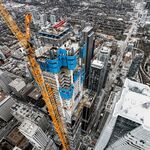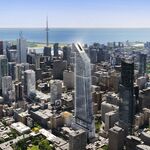Toronto's Union Station is the focus of several concurrent restoration, renovation, and redevelopment schemes meant to give the city's Downtown gateway a major facelift and boost its capacity significantly for moving people. While the Union Station revitalization project may be the best known of the projects, another major component—a new platform for the TTC's Union Subway Station—made a big step forward on Monday with initial opening. There's still a lot of work to come at the station, including a glass mural that will span its 500 feet.
UrbanToronto recently met up with Toronto artist Stuart Reid, who was commissioned to create the work. He currently teaches Environmental Design at OCAD University and has been working as a glass artist since 1974. Public art is not new to Reid, whose other works include stained glass windows for Toronto's St. James Cathedral which were dedicated by Queen Elizabeth II, a 4- storey breezeway for Holland Bloorview Kids Hospital, and other local and international commissions. We met with Reid at his South Annex home to discuss his piece for Union Station, Zones of Immersion.

Model and digital design for Zones of Immersion mural, image courtesy of Stuart Reid
We sat down in Reid's home office-studio to have our conversation. The room had a L-shaped desk with two large Mac monitors arranged perpendicularly to each other. Along one wall there were a set of French doors leading out to a small balcony. The desk and walls were full with handwritten notes, paperwork and drafts of the artist's work. This place, he explained, was where he has digitally developed the design over the past 6 years.

Image of Zones of Immersion in progress, image courtesy of by D. Balabanoff and L. Voigt

A series of panels from Zones of Immersion, image courtesy of Glasmalerei Peters Studios
"Everything started in 2007 when I entered the competition with a digital collage of text, sketches, and colour fields" Reid recalls. Since then the work has taken him on quite a journey… from intial sketches and design work, to collaborating with a glass factory in Vaughan, through the intense difficulty of the initial fabricator's bankruptcy, and finally to the outskirts of Paderborn, Germany where the work was successfully completed by Peters Studios. Reid worked closely with this renowned German studio, which specializes in glass painting and new glass technologies. He made six trips overseas to work for months at a time, had-painting and acid-etching the glass panels. The work was completed this past February, and arrived by ship in June 2014. It awaits installation once the platform is complete in late 2014 or early 2015.

Stuart Reid with one panel of Zones of Immersion, image courtesy of Glasmalerei Peters Studios
The mural is composed of black and white drawings of subway life, poetic texts, and areas of pure colour, whose flow into each other references the rhythm of the subway trains. The translucent and transparent imagery combines digital colour printing with graphite hand drawing, acid-etching of specially hand-blown glass, and sandblasting. The images are drawings that Reid made of subway passengers that he saw as he "rode the rocket" over a period of years. The poems accompany some of the drawings directly, while others are simply about the experience of passing through the "subterranean veins" that connect the city.

A glass panel from Zones of Immersion, image courtesy of Glasmalerei Peters Studios
Designing a 500 foot mural is no easy feat, especially when taking in to consideration the environment of the TTC. There were several criteria that Reid's work had to satisfy in order for it to function properly in its designated space. Given the fact that TTC trains, at least the newer ones, reach 65 km per hour and come speeding into their stations, there is a lot of air movement and pressure changes in these tight tunnels. Although Reid's work is glass, it has been tempered and laminated to withstand these pressure changes in the tunnel and maintain its form.
Zones of Immersion also had to be resilient to harsh cleaners that would be used to get rid of the dust that the trains would blow on to the mural as well as potential defacement. Reid did this by encasing the work in a heavy-duty glass box made for long lasting wear and tear. Lastly, the design had to accommodate refuge cages, the small boxes peppered along the length of the platform for subway workers to jump into when a train enters the platform while they are on the job. This meant that the mural is not completely parallel to the platform; it jogs in and out to allow room for these refuge cages.

New South platform where Zones of Immersion will be housed, image by Jack Landau
Reid says the project had many phases to its development: “First I had the concept, then I did the notebook sketches and texts travelling on the TTC, and then I synthesized these into a final design presentation; this was the package that I won the competition with. Then, due to structural considerations of the station's overhead beams, the height—and therefore the proportions of the mural—had to change, so this forced a major re-design. But the really big problem was that my sketches had to move from ‘notebook size’ to ‘full wall size’. The images that looked fine when they were drawn at 6” tall in my notebook were inadequately blurry when the image was enlarged to 7’ tall, so I decided I had no real choice but to draw the figures life size. That is what I did in 2011 in a series of graphite and India Ink drawings (3.5’ x 7’) entitled 'In Transit'.”
These drawings came directly out of the sketches Reid did in 2007 and later in 2008, but with the new larger scale he was able to detail not just the physical characteristics of his subjects but the psyche of the various sitters. During his rides he sought to really immerse himself in the experience of being in the subway, a place that both isolates and unites its users. He would sit on the train and sketch passengers that caught his attention. "Sometimes they stare back, look away or just get up and leave," Reid said of his subjects. The ones that sat down long enough for him to get a good look at them, gave him some very interesting works of art and some stories. Reid has a knack for capturing the emotion, mystery and intrigue that each of us experiences when observing our fellow subway-users. His sketches are not extremely detailed in capturing the physicality of his subjects, but they do capture something much more interesting, and perhaps profound.
One of his sketches, Reading Music, shows a man bent over a book, poring over it with great interest and purpose. Not all of Reid’s full scale drawings are as pensive or sweet or positive as this one. The drawing “Life over lifestyle” shows a besieged mother with a black eye holding a baby as he picks his nose. While the finished glass panel in the subway mural (with the same theme) softens the harsh beauty of this drawn image into a melancholic mother and child, the juxtaposition of the many moods and manners of subway life is clearly drawn straight from the experiences he witnessed. Both the mother and child and the older man reading sheet music are part of the richness and poignancy of life on the subway.

"Reading Music" from Reid's In Transit Series, image courtesy of Stuart Reid

"Life Over Lifestyle" from Reid's In Transit Series, image courtesy of Stuart Reid
That is the ethos of Zones of Immersion. Stuart Reid's mural is a "work about the subway that is made for people who use it." His work is fair in that it embraces the unpleasant as much as the light-hearted. He acknowledges that the subway is not the most cheerful place and he doesn't try to change that. He wants the thousands of people who use it everyday to be more aware of their surroundings and allow themselves to appreciate what a unique and beautiful space it can be. He does add some cheer by setting his text and drawings against patches—zones—of bright colours to enliven what can sometimes be a dismal environment. He hopes that this mural, which will not be far from arms reach for passengers, will allow passengers to immerse themselves in the subway experience.
When talking with Reid he expressed that the work, although technically finished, was not complete. It still has to be transported to Union Station, installed at the platform and lit appropriately among other things. Now that the south platform is open, work to install this on the old centre platform will start soon, and it should not be long before we see the final product. No doubt this new addition to Union Station will enhance more than one aspect of riding the Rocket.
| Related Companies: | Arcadis, EllisDon |

 4.2K
4.2K 


















































